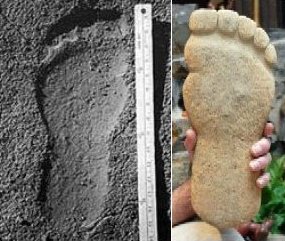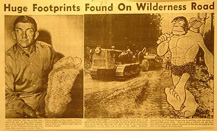
October 30, 2008

An Editorial Response to “Birth of Bigfoot”
The Times-Standard had a great opportunity to celebrate its place in history, to note a major 50-year-old milestone, and to unfold, from their archives, an article worthy of the moment. That point in time was the event five decades ago that saw the birth of the naming of “Bigfoot,” when the hairy forest giants evolved from marginal news stories about “wild people,” “Sasquatch” (mostly Canadian) and “American Abominable Snowmen.”
Instead, as you can see from the treatment of this historical pivotal point in John Driscolli’s column below, the California newspaper blew it. From dipping to the position of ridicule to kick off the article to the psychobabble questioning of the seriousness of Andrew Genzoli’s first caption under the photo of the Jerry Crew cast, the newspaper absolutely neither understands nor captures their significant place in history. They have trivialized themselves.

As many of you know, I consider there is reality in the notion that Ray Wallace’s central role in promoting various incidents of hoaxing at Bluff Creek in 1958-1960, and later, is well-established. Faking occurred, no doubt about it. I am on the same page with The Times-Standard about a few elements of which they speak, for it appears, after Jerry Crew’s initial encounters, Ray Wallace hoaxed various easily-found tracks and supported fictional scenarios by his relatives and friends.
After I told Steve Young at the Seattle Times to talk to the Wallace family immediately after the death of Ray Wallace, Young discovered new details behind Wallace’s trickster stories. Death can be a harsh revealer of realities, and yet truth is a worthy objective within cryptozoology. I did not fear what would be uncovered, for a cleaning of house is always welcome, as the better database remaining would be helpful for finding new species.
However, that Wallace “invented” Bigfoot, or that every facet of his involvement should be believed by all in the media goes beyond any reasonable thought. When newspapers begin to swallow – hook, line, and sinker – all parts of the twisted tales from a known hoaxer, we run the risk of inhabiting the borderline area that spreads poison beyond the parameters of any original story. Why are all details from the one telling the tall tales to be so fully now taken as truthful?
For The Times-Standard to state with a straight face that there was a grand conspiracy on the ground in Bluff Creek during 1958, which included the local newspaper office, must be viewed as skeptically as some of Wallace’s old yarns about Bigfoot guarding gold mines or that he had seen UFOs a total of 2000 times. Indeed, the gullibility and journalistic hoax – the one about him being the “father of Bigfoot” – which is being continued globally into the present from the late Wallace’s imagination is downright remarkable.
In regard to a specific argument that the media is still falling head over heels for the “Wallace hoax” to explain everything tied to Bigfoot and its origins, a criticism put forth by John Green, a former newspaperman himself, that is a position with Green to which I subscribe wholeheartedly. It boggles the mind that the media can move from reporting, with all seriousness in 1958, about new evidence of this thing called “Bigfoot,” to then establish a position today of righteous indignation.
The Wallace story is a cautionary tale. I would say to The Times-Standard: “Just because someone, especially an acknowledged liar, claims to have made something up, doesn’t mean that new tale he or his relatives are telling you is the full truth.”
~ Loren Coleman

John Driscoll/The Times-Standard
Article Launched: 10/30/2008 01:30:55 AM PDTMaybe it was bad light or bad mushrooms. Maybe it was someone in a stitched-up bear skin creeping up on the bonfire to scare the wits out of his brother. Or maybe it really was a rare primate that wandered near camp in the dark several thousand years ago that caught someone’s eye.
However it happened, Sasquatch was hatched into the human consciousness, long, long ago.
But Bigfoot strode into the picture just 50 years ago this month. Born in the pages of the Humboldt Times by columnist Andrew Genzoli, the word Bigfoot was to become the new operating title for the hairy beast of lore.
In Bluff Creek off the Klamath River this month in 1958, Jerry Crew and his road construction crew found tracks of a Sasquatch, the story goes. Crew made a plaster cast of the impressions, and brought them into the Times on Oct. 4.
Genzoli recorded that the men called the creature Big Foot.
”There is a mystery in the mountains of northeastern Humboldt County, waiting for a solution … Who is making the huge 16-inch tracks in the vicinity of Bluff Creek?” Genzoli wrote in the front page story below a classic photo of Crew with a plaster cast of the big foot. “Are the tracks a human hoax? Or, are they actual marks of a huge but harmless wild-man, traveling through the wilderness? Can this be some legendary sized animal?”
It’s difficult to know how seriously Genzoli took the story, and he raises some questions about the claim and introducesskeptics to balance the piece.
Then things started getting weird. A $1,000 reward was offered to anyone who could explain the mystery, which was, proclaimed the Times’ sister paper the Humboldt Standard, either a hoax or “a mentally deficient, over-grown boy gone wild.”
Only 10 days later, it was Times reporter Bill Chambers on the case. Chambers reported that the Humboldt County Sheriff’s Office was convinced they had the man responsible for the footprints in Bluff Creek, and that he would confess.
But when construction worker Ray Wallace — the supposed hoaxer — was contacted by the Times about the allegations, he reacted angrily.
”I’m not going in. If they want to put out a warrant I’m going to sue them for slander — and I won’t fool around about it!” Wallace said. “If they think they’re going to make a laughing stock out of me, they’ve got another thing coming.”
Wallace’s brother W.R. “Shorty” Wallace insisted that no one would work all day in the Bluff Creek country and then run around planting footprints.
The Oct. 15 Times edition featured a huge photo spread, with Chambers reporting that “Bigfoot has been seen.” Two construction workers had seen a Sasquatch and told him all about it. The Standard on Oct. 16 said the witnesses were, “Two husky construction workers with good eyesight,” in an effort to eliminate doubt.
Now look, anyone who’s ever been the victim of a good hoax knows just how seriously it can be taken by its perpetrators. Things take on an overblown quality. Characters involved in successful hoaxes play different roles to satisfy the victim or victims who take different approaches to interpreting a mystery.
Shorty Wallace’s explanation that no one would stomp around making footprints after work is obvious bunk in hindsight. His role likely was to instill doubt. Ray Wallace’s vehement denial of the allegation — even threatening to go to the courts — was likely meant to make him the untouchable martyr.
The husky construction workers with good eyesight were probably enlisted to play the role of true believers. Jerry Crew provided the ever-important introduction of evidence, to get the ball rolling and feel out initial reactions.
We now know the whole thing was a hoax — or a brash attempt to claim credit for one. Late in 2002, Ray Wallace died at the age of 84 in Washington. But he didn’t take Bigfoot to the grave with him; he had spilled his guts to a few members of his family. The man who insisted he’d “sue the for slander” had confessed to being the original Bigfoot hoaxer, his son and nephew told the Seattle Times.
What was surprising was what the Times-Standard — that descendant of the original Bigfoot newspapers — learned upon news of Wallace’s death. The Times-Standard called June Beal, wife of deceased Times editor L.W. “Scoop” Beal, to find out if she knew anything about it. June Beal was a perpetually pleasant person who until shortly before her death in July 2007 visited the newsroom regularly to chat.
June Beal told the Times-Standard that she’d been mum on the topic for nearly five decades, even as she watched it spiral out of control. Finally, with Wallace’s death, she was willing to share her secret.
”They were in on this hoax,” June Beal said of her husband and Wallace. “It was just a fun thing and the fun got out of hand.”
It certainly explains Chambers’ almost complete lack of skepticism in his reporting at the time. It also shows how newspapers — especially at the time — had an incredible influence on events, as Bigfoot became infused into the minds of the adventurous, the scared and the gullible.Bigfoot made a massive resurgence when Roger Patterson supposedly filmed a Bigfoot near Bluff Creek in 1967. That footage is still some of the most relied on for both skeptics and believers regarding the existence of Sasquatch.
To be sure, the Sasquatch and the wild man have long been a part of myth and legend. And as Idaho State University researcher Jeff Meldrum — a primary advocate of the existence of the man-beast — said, not all the footprints cast in plaster over the years could possibly have been hoaxes.
This goes back to the rule for misinformation and general trickery: Just because you made it up, doesn’t mean it isn’t true.

About Loren Coleman
Loren Coleman is one of the world’s leading cryptozoologists, some say “the” leading living cryptozoologist. Certainly, he is acknowledged as the current living American researcher and writer who has most popularized cryptozoology in the late 20th and early 21st centuries.
Starting his fieldwork and investigations in 1960, after traveling and trekking extensively in pursuit of cryptozoological mysteries, Coleman began writing to share his experiences in 1969. An honorary member of Ivan T. Sanderson’s Society for the Investigation of the Unexplained in the 1970s, Coleman has been bestowed with similar honorary memberships of the North Idaho College Cryptozoology Club in 1983, and in subsequent years, that of the British Columbia Scientific Cryptozoology Club, CryptoSafari International, and other international organizations. He was also a Life Member and Benefactor of the International Society of Cryptozoology (now-defunct).
Loren Coleman’s daily blog, as a member of the Cryptomundo Team, served as an ongoing avenue of communication for the ever-growing body of cryptozoo news from 2005 through 2013. He returned as an infrequent contributor beginning Halloween week of 2015.
Coleman is the founder in 2003, and current director of the International Cryptozoology Museum in Portland, Maine.
Filed under Abominable Snowman, Bigfoot, Cryptomundo Exclusive, Cryptotourism, CryptoZoo News, Cryptozoologists, Cryptozoology, Media Appearances, Pop Culture, Public Forum, Sasquatch, Twilight Language, Year In Review, Yeti